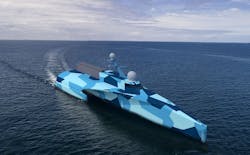THE MIL & AERO COMMENTARY – U.S. military leaders are getting serious about developing unmanned surface vessels for jobs like the global transport of military cargo, moving troops and support personnel, anti-submarine warfare, maritime surveillance, and even offensive operations against enemy ships.
U.S. Department of Defense (DOD) agencies awarded two significant contracts earlier this month to develop enabling technologies for unmanned surface vessels (USVs) able to operate independently for long periods over vast ocean areas -- even in rough seas and high waves.
The two September contracts involve the U.S. Navy's Large Unmanned Surface Vehicle (LUSV), and the Sea Train project of the U.S. Defense Advanced Research Projects Agency (DARPA) in Arlington, Va.
The Navy has awarded contracts to six companies to take the first steps in determining what the service’s large USV will look like. The LUSV's missions would include anti-surface and strike warfare. The LUSV will offer autonomy, endurance, precision navigation, and command-and-control.
The Navy has announced $42 million in LUSV preliminary studies. The contractors are Austal USA in Mobile, Ala.; Huntington Ingalls Industries in Newport News, Va.; Fincantieri Marinette Marine in Marinette, Wis.; Bollinger Shipyards in Lockport, La.; Lockheed Martin Corp. in Bethesda, Md.; and Gibbs & Cox Maritime Solutions in Arlington, Va.
Each contractor won about $7 million to kick off work on the program. The LUSV studies will refine requirements, explore alternative design approaches, find ways to improve reliability, and plan for electronics, electrical and mechanical systems.
These surface drones, operating together with surface ships, undersea drones, aerial drones, and submarines, promise to change the character of maritime warfare, Navy officials say.
The DARPA Sea Train project, meanwhile, will develop enabling technologies to make it easier for military forces to cross oceans by using a system of connected unmanned surface vessels that would act as trains across the seas.
Related: Not just for the Navy: unmanned surface vessels (USVs) in wide use for surveillance at NOAA
DARPA awarded a $13.9 contract in September to Applied Physical Sciences Corp. in Groton, Conn. The potential value of the contract is as much as $31.3 million. Applied Physical Sciences experts will focus on enabling extended transoceanic transit and long-range naval operations by capitalizing on the efficiencies of a system of wave-resistant connected vessels using a distributed fleet of tactical unmanned ships.
The idea is to deploy lines of medium-sized unmanned ships that could help reduce the forces of waves. DARPA researchers say the sea trains could be formed by physically connecting vessels loosely, or by sailing vessels in formations.
Leaders of the U.S. Navy and Marine Corps are trying to shift from centralized operations on a few large manned surface ships to a distributed fleet of relatively small and low-risk vessels for safe ocean transit.
A key limitation of unmanned ships is their limited ranges because of the effects of large ocean waves on medium-sized vessels. At-sea refueling, heavy-lift ships, strategic airlift, and increased overall vessel size all are solutions to this limitation, but are vulnerable to enemy submarines, surface warships, and combat aircraft.
The connected sea train has a physical connection between four or more vessels during transit to form a long parallel mid-body for the vessel to decrease the vulnerability to waves, while enabling the vessels to disconnected from time to time to conduct tactical missions.
The connectorless sea train uses compressive forces to keep four or more vessels together in a long parallel mid-body for the vessel to decrease the vulnerability to waves, while enabling the vessels to disconnect to conduct tactical missions.
Related: Navy moves to low-rate initial production of minehunting unmanned surface vessel
The formation sea train involves four or more vessels moving together in groups formed closely front and back, and side to side, to exploit wave interference between the vessels.
The Sea Train project seeks to design a hull that makes the most of drag reduction; control surfaces for maneuvering and seakeeping; ways to connect to several medium-size unmanned ships; and low-drag propulsion.
DARPA experts envision the Sea Train's control architecture with real-time networked computers able to share information among vessels -- especially by linking weather forecasts with path planning and seakeeping; and ways to monitor vessel performance.
About the Author
John Keller
Editor-in-Chief
John Keller is the Editor-in-Chief, Military & Aerospace Electronics Magazine--provides extensive coverage and analysis of enabling electronics and optoelectronic technologies in military, space and commercial aviation applications. John has been a member of the Military & Aerospace Electronics staff since 1989 and chief editor since 1995.
